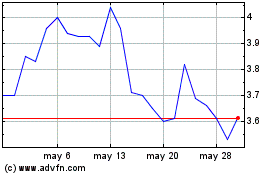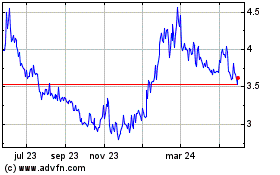Atea Pharmaceuticals, Inc. (Nasdaq: AVIR) (Atea), a clinical-stage
biopharmaceutical company engaged in the discovery and development
of oral antiviral therapeutics for serious viral diseases, today
announced the presentation of two posters supporting the
combination of bemnifosbuvir, an oral nucleotide polymerase
inhibitor, and ruzasvir, an oral NS5A inhibitor, as a potential
treatment for Hepatitis C Virus (HCV) at the American Association
for the Study of Liver Diseases’ (AASLD) The Liver Meeting 2023,
being held from November 10-14, 2023 in Boston, MA.
“Results from these two presented studies further support the
potential use of these two drug candidates in combination as a
novel treatment for HCV. Phase 1 data demonstrate that
coadministration of bemnifosbuvir and ruzasvir was well tolerated
and not affected by food or concomitant dosing, indicating a low
risk of drug-drug interactions,” said Jean-Pierre Sommadossi, PhD,
Chief Executive Officer and Founder of Atea Pharmaceuticals.
“Moreover, in vitro data demonstrate that the combination of
bemnifosbuvir and ruzasvir retained potent pan-genotypic antiviral
activity against major HCV NS5A and NS5B resistance-associated
variants and hard-to-treat sub-genotypes, which have been
identified in certain HCV patients who have failed treatment with
currently available therapies.”
“We are very pleased with the substantial progress achieved in
our Phase 2 combination study of bemnifosbuvir and ruzasvir for the
treatment of HCV this year, and we expect to announce results from
the 60-person lead-in cohort in early 2024,” continued Dr.
Sommadossi. “We look forward to progressing the clinical
development of this potent direct-acting antiviral combination for
the potential benefit for millions of patients who, despite
available treatments for HCV, remain underserved.”
Poster Number: 1879-ADate and
Time: Friday, November 10, 1:00 p.m. – 2:00
p.m.Location: Hall
ATitle: Lack of Pharmacokinetic Drug-Drug
Interaction Between Bemnifosbuvir and Ruzasvir in Healthy
Participants
Results from a Phase 1 study in 32 healthy adult participants
demonstrate that the coadministration of bemnifosbuvir and ruzasvir
was well tolerated, and plasma pharmacokinetic (PK) profiles
remained generally unaffected by food or concomitant dosing,
indicating a lack of drug-drug interaction between the two drug
candidates. Two cohorts (n=16) were dosed at either (i) 550 mg
bemnifosbuvir once-daily for 18 days and 180 mg ruzasvir once-daily
starting at Day 7 through Day 18 or (ii) 180 mg ruzasvir once daily
for 18 days and bemnifosbuvir 550 mg once-daily starting at Day 7
through Day 18. No deaths or serious treatment-emergent adverse
events (TEAEs) were reported and no participants withdrew due to a
TEAE. These Phase 1 data support the continued clinical evaluation
of these two potent drug candidates in combination for the
treatment of HCV.
Poster Number: 1861-ADate and
Time: Friday, November 10, 1:00 p.m. – 2:00
p.m.Location: Hall
ATitle: Bemnifosbuvir and Ruzasvir are Potent
HCV DAAs with Favorable Antiviral Profiles Against Major HCV NS5A
and NS5B RAVs Supporting Use in Combination
Results from an in vitro study demonstrate that the combination
of bemnifosbuvir and ruzasvir has potent pan-genotypic antiviral
activity against major HCV NS5A and NS5B RAVs and hard-to-treat
sub-genotypes. Furthermore, results demonstrate that bemnifosbuvir
is approximately 10-fold more potent than sofosbuvir (SOF)
and retained full potency against all HCV GT-1a and GT-3a NS5A
RAVs tested. Based on these in vitro results combined
with other data to date, the combination of bemnifosbuvir and
ruzasvir is expected to retain antiviral activity against major
clinically relevant HCV NS5A and NS5B RAVs. The combination of
bemnifosbuvir and ruzasvir has the potential to be a promising
treatment option for HCV infection, given the potent, pan-genotypic
antiviral activity of bemnifosbuvir and ruzasvir, the high
resistance barrier of bemnifosbuvir, previously reported clinical
safety and antiviral activity data for each drug candidate when
administered individually, lack of drug-drug interactions between
the two drug candidates, and complementary mechanisms of
actions.
About Hepatitis C Virus (HCV)
HCV is a blood-borne, positive sense, single-stranded RNA virus,
primarily infecting cells of the liver. HCV is a leading cause of
chronic liver disease and liver transplants and spreads via blood
transfusion, hemodialysis and needle sticks. In the United States,
injection drug use accounts for approximately 60% of all new cases
of HCV. Diagnosis of HCV is made through blood tests, including
molecular tests that allow for the detection, quantification and
analysis of viral genomes and the classification of an infection
into specific viral genotypes. Infection becomes chronic in 75% to
85% of cases, with an incubation period lasting from two to 26
weeks.
HCV is classified into seven genotypes and 67 subtypes, with
genotype 1 being responsible for more than 70% of HCV cases in the
United States. Patients with HCV are also classified by liver
function status: compensated cirrhosis (liver scarring) denotes
those patients that do not yet have impaired liver function, while
decompensated cirrhosis describes patients with moderate to severe
liver function impairment.
The HCV patient population continues to grow dramatically in the
United States. A large portion of the current increase in incidence
is attributable to the opioid crisis, injection drug use and HCV
reinfection. The prevalence of HCV in the US is expected to
continue to remain steady over the coming years as rising HCV
incidence offsets the number of new patients treated. The HCV
market was approximately $3.5 billion in global net sales in 2022,
with approximately 50% of such net sales attributable to the
US.
About Bemnifosbuvir and Ruzasvir for Hepatitis
C Virus (HCV)
Bemnifosbuvir, an oral nucleotide polymerase inhibitor, has been
shown to be approximately 10-fold more potent than SOF in
vitro against a panel of laboratory strains and clinical
isolates of HCV genotypes 1–5. In vitro studies
demonstrated bemnifosbuvir remained fully active against SOF
resistance-associated strains (S282T), with up to 58-fold more
potency than SOF. The PK profile of bemnifosbuvir supports
once-daily dosing for the treatment of HCV and bemnifosbuvir has
been well-tolerated at doses up to 550 mg for durations up to 8-12
weeks in healthy and HCV-infected subjects.
RZR, an oral NS5A inhibitor, has demonstrated highly potent and
pan-genotypic antiviral activity in preclinical (picomolar range)
and clinical studies. RZR has been administered to over 1,200
HCV-infected patients at daily doses of up to 180 mg for 12 weeks
and has demonstrated a favorable safety profile. RZR’s PK profile
supports once-daily dosing.
About Atea Pharmaceuticals
Atea is a clinical stage biopharmaceutical company focused on
discovering, developing and commercializing oral antiviral
therapies to address the unmet medical needs of patients with
serious viral infections. Leveraging the Company’s deep
understanding of antiviral drug development, nucleos(t)ide
chemistry, biology, biochemistry and virology, Atea has built a
proprietary nucleos(t)ide prodrug platform to develop novel product
candidates to treat single stranded ribonucleic acid, or ssRNA,
viruses, which are a prevalent cause of serious viral diseases.
Atea plans to continue to build its pipeline of antiviral product
candidates by augmenting its nucleos(t)ide platform with other
classes of antivirals that may be used in combination with its
nucleos(t)ide product candidates. Currently, Atea is focused on the
development of orally-available antiviral agents for serious viral
infections, including severe acute respiratory syndrome coronavirus
2 (SARS-CoV-2), the virus that causes COVID-19, and hepatitis C
virus (HCV). For more information, please visit
www.ateapharma.com.
Forward-Looking Statements
This press release contains forward-looking statements within
the meaning of the Private Securities Litigation Reform Act of
1995. All statements contained in this press release that do not
relate to matters of historical fact should be considered
forward-looking statements, including without limitation statements
regarding our expectations surrounding the potential of our product
candidates, including the combination of bemnifosbuvir and ruzasvir
for the treatment of HCV. These statements are neither promises nor
guarantees, but involve known and unknown risks, uncertainties and
other important factors that may cause our actual results,
performance or achievements to be materially different from any
future results, performance or achievements expressed or implied by
the forward-looking statements. These and other important factors
discussed under the caption “Risk Factors” in our Annual Report on
Form 10-K for the year ended December 31, 2022 and our other
filings with the SEC could cause actual results to differ
materially from those indicated by the forward-looking statements
made in this press release. Any such forward-looking statements
represent management’s estimates as of the date of this press
release. While we may elect to update such forward-looking
statements at some point in the future, we disclaim any obligation
to do so, even if subsequent events cause our views to change.
Contacts
Jonae BarnesSVP, Investor Relations and Corporate
Communications617-818-2985barnes.jonae@ateapharma.com
Will O’ConnorStern Investor Relations
212-362-1200will.oconnor@sternir.com
Atea Pharmaceuticals (NASDAQ:AVIR)
Gráfica de Acción Histórica
De Dic 2024 a Ene 2025

Atea Pharmaceuticals (NASDAQ:AVIR)
Gráfica de Acción Histórica
De Ene 2024 a Ene 2025
